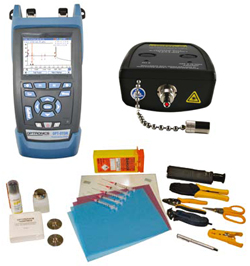Smart Robotic Vision Systems for Optimized Automation and Precision Tasks
Smart Robotic Vision Systems for Optimized Automation and Precision Tasks
Blog Article
Crucial Functions to Try To Find in Optical Fibre Screening Devices
When evaluating optical fiber testing tools, a number of important attributes require mindful consideration to make certain optimum efficiency and reliability. Compatibility with existing sector standards boosts functionality, while sophisticated dimension capabilities, consisting of TDR and OTDR screening, offer essential insights right into network integrity. Recognizing these features will lose light on how to select the appropriate equipment for your details requirements.
Precision and Precision
Precision and precision are vital criteria in the evaluation of optical fibre screening tools. These two qualities make sure that dimensions reflect the real efficiency of fibre optic systems, which is important for efficient network installment, upkeep, and troubleshooting. Accuracy refers to the closeness of a determined worth to the real worth, while accuracy represents the repeatability of measurements under unchanged conditions.
When choosing optical fibre screening tools, it is vital to consider instruments that offer high accuracy and precision to reduce mistakes in information analysis. Tools such as optical time-domain reflectometers (OTDRs) and power meters should have calibration mechanisms to ensure consistent performance in time. Additionally, the specifications offered by producers ought to detail the equipment's measurement unpredictability, which straight influences the integrity of examination outcomes.
Furthermore, the performance of optical fiber testing devices can be affected by environmental variables, such as temperature and moisture. Therefore, selecting equipment created to alleviate these variables will certainly boost dimension fidelity. Finally, purchasing optical fiber screening devices with robust precision and precision attributes is basic for preserving ideal network performance and guaranteeing the honesty of fiber optic communications.

User-Friendly User Interface
The efficiency of optical fiber testing devices is not solely figured out by its precision and precision; a straightforward interface plays a considerable duty in enhancing functional performance. A well-designed user interface streamlines the interaction between the service technician and the equipment, enabling for an extra instinctive understanding of complex functions.
Trick attributes of an user-friendly interface consist of clear navigating menus, logical designs, and easily available controls. These aspects make it possible for technicians to carry out examinations promptly without considerable training, reducing the possibility of individual mistake - ofda. In addition, aesthetic indications such as progress bars, alerts, and graphical representations of data can considerably improve the individual experience by supplying instant responses on the screening procedure.
In addition, personalized settings can better improve procedures by allowing individuals to change specifications according to details testing needs. This flexibility not just conserves time but likewise ensures that the devices meets diverse application demands.
Incorporating help features, such as tooltips and extensive handbooks, into the interface can even more empower customers, promoting self-sufficiency and confidence in running the tools. Eventually, an user-friendly user interface is necessary for taking full advantage of the potential of optical fibre screening devices, bring about much more effective and effective testing results.
Transportability and Sturdiness
Mobility and durability are vital characteristics of optical fiber testing devices, making certain that it can withstand the roughness of various environments while staying very easy to transport. Service technicians frequently function in varied settings, from telecommunications hubs to remote setups, making it vital that screening tools are lightweight and portable (ofda). Equipment developed with transportability in mind typically features ergonomic manages and situations that promote easy motion, therefore enhancing operational effectiveness on-site
Resilience is similarly essential, as optical fibre testing equipment is often revealed to severe conditions, including temperature changes, moisture, and physical influences. Gadgets constructed with tough products such as strengthened plastics or metal housings are much better matched for these settings, minimizing the risk of damage during use and transport. In addition, tools with water and dust resistance ratings, such as IP ratings, ensures trusted efficiency in challenging conditions.
Compatibility With Specifications
Guaranteeing compatibility with market standards is essential for optical fibre testing tools, as it directly affects the integrity and credibility of examination results. Optical fiber networks go through stringent performance criteria developed by numerous companies, including the Telecoms Sector Association (TIA) and optical fibre testing equipment the International Electrotechnical Payment (IEC) Testing devices must adhere to these requirements to make sure that dimensions are constant and similar throughout various systems and atmospheres.
When picking optical fiber screening devices, customers ought to confirm that the device fulfills appropriate criteria significant to their particular application, such as those pertaining to depletion, data transfer, and crosstalk. Equipment that is certified with well established standards not only helps in attaining accurate outcomes yet additionally promotes interoperability amongst tools from different suppliers.
Furthermore, compatibility with standards ensures that the devices can be utilized in governing compliance scenarios, which is critical for jobs in markets such as telecoms, aerospace, and military applications. For that reason, buying optical fiber testing devices that aligns with existing market standards is an essential element of maintaining quality guarantee and accomplishing optimal network efficiency.
Advanced Dimension Abilities
Advanced dimension capacities are a defining function of modern-day optical fibre screening tools, enabling comprehensive evaluation of network performance. These capacities ensure that professionals can assess vital parameters such as signal loss, dispersion, and transmission capacity, which are important for preserving optimal interaction efficiency.
One secret aspect is the capability to conduct time-domain reflectometry (TDR) and optical time-domain reflectometry (OTDR) tests. These techniques make it possible for customers to determine faults, gauge the size of fibres, and identify the place of flaws with exceptional accuracy - ofda. In addition, innovative equipment frequently includes the ability to determine optical power degrees, assisting to analyze the overall health and wellness of the network and make certain compliance with the needed requirements.
In addition, some testing tools provide innovative algorithms for real-time evaluation, making it possible for quicker diagnosis and troubleshooting. In verdict, spending in optical fibre screening equipment with sophisticated dimension capacities is necessary for making sure network dependability and performance in today's demanding telecommunications landscape.
Verdict

Report this page